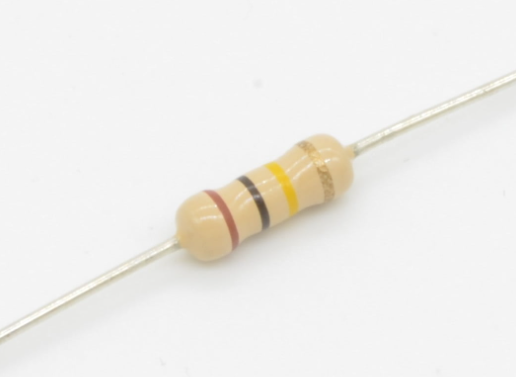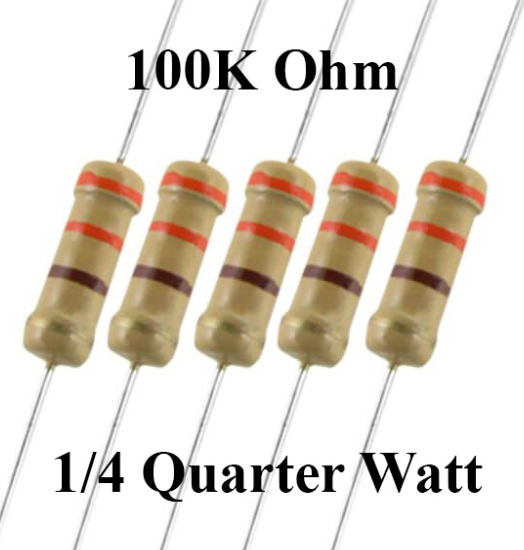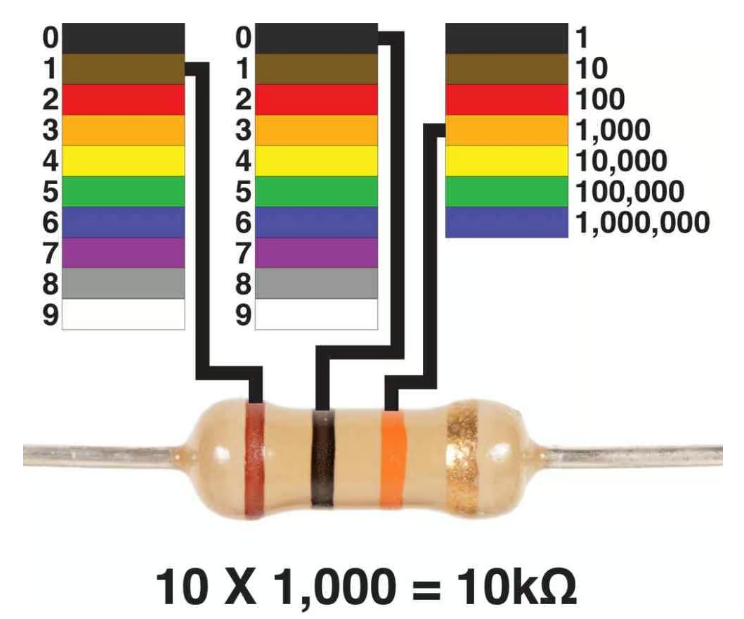What is a 100k Resistor? 100k Ohm Resistor Color Code

What is a 100k Resistor?
Resistors are passive components in electronic circuits that restrict the flow of electrical current. A 100k resistor, also known as a 100,000-ohm resistor, is a crucial component in electronic circuits. It resists the flow of electric current, helping to manage voltage and current levels within a circuit. The "100k" designation indicates that the resistor has a resistance value of 100,000 ohms, which is often needed for various electronic and electrical applications. Resistors like the 100k one are essential for ensuring that electronic devices operate correctly and safely.
Among the different types available, the 100k ohm resistor is one of the higher resistance values commonly produced by manufacturers. Despite its small size, it provides significant resistance, making it useful in various applications. It's often used as a bleed resistor alongside capacitors to prevent unwanted electrical discharges and is also vital in adjusting sensitive audio and video circuits.
The resistor color code is a visual system that helps identify the resistance of a resistor using a series of 3, 4, or 5 color bands. Each color band represents a specific number that contributes to the resistor's total value. It's important to note that the resistor's body color doesn't carry any meaning in this coding system.
Understanding the purpose of each color band is essential. In a four-band resistor, the first three bands show the nominal value, while the fourth band indicates the tolerance. For five-band resistors, the first four bands represent the nominal value, and the fifth band shows the tolerance. In six-band resistors, an extra band is added to show the temperature coefficient, which measures how the resistor's value changes with temperature fluctuations.
100k Resistor Color Code
Color code is the identification of any resistor. A layman may consider it some ordinary line on a resistor. A circuit designer or electrical engineer knows well the purpose of these lines. Color codes have some values and help to calculate the resistance of the resistor.
The color code on a 100k resistor helps to identify its resistance value. This code consists of colored bands painted on the resistor. Each color represents a specific number or multiplier. For a 100k resistor, the color bands are typically brown, black, yellow, and sometimes a tolerance band. Here’s a breakdown of what each color signifies:
l Brown: 1
l Black: 0
l Yellow: Multiplier of 10,000
l (Tolerance Band, often Gold or Silver): Indicates the precision of the resistor.

How to Read the 100k Ohm Resistor Color Code
Reading the color code on a resistor can seem daunting at first, but it becomes easier with practice. Start by identifying the color bands from left to right. For a 100k ohm resistor, the sequence is typically brown, black, and yellow:
First Band (Brown): Represents the first digit, which is 1.
Second Band (Black): Represents the second digit, which is 0.
Third Band (Yellow): Indicates a multiplier of 10,000.
(Tolerance Band): Provides information on the resistor's accuracy.
Combine these values to get 10 × 10,000 = 100,000 ohms, or 100k ohms.
The 4 Band 100k Ohm Resistor
Most 100k resistors are 4-band types. The fourth band usually indicates tolerance, which can vary depending on the resistor's precision. For instance, a gold band typically signifies a tolerance of ±5%, while a silver band indicates ±10%. Understanding the fourth band helps you know how much the actual resistance might differ from the nominal value.
5-Band vs. 6-Band 100k Ohm Resistor
Color Code
Resistors come in various configurations, and the 5-band and 6-band versions offer higher precision compared to the standard 4-band resistors. Each type serves specific purposes and provides different levels of accuracy and detail.
5-Band Resistors
5-band resistors are designed for applications requiring higher precision. They offer an additional significant digit, which enhances the accuracy of the resistor's value. For a 100k ohm resistor with a 5-band code, the sequence is:
First Band (Brown): Represents the first significant digit, which is 1.
Second Band (Black): Represents the second significant digit, which is 0.
Third Band (Brown): Represents the third significant digit, which is 1.
Fourth Band (Black): Indicates the multiplier of 10,000.
Fifth Band (Tolerance Band): Shows the tolerance level, such as ±1% for a more precise resistor.
6-Band Resistors
6-band resistors are even more precise, used in high-accuracy applications such as precision analog circuits. They include an additional band for the temperature coefficient, which helps account for changes in resistance due to temperature variations. The color code for a 100k ohm resistor in a 6-band configuration is:
First Band (Brown): First significant digit (1).
Second Band (Black): Second significant digit (0).
Third Band (Brown): Third significant digit (1).
Fourth Band (Black): Multiplier of 10,000.
Fifth Band (Tolerance Band): Tolerance, often ±0.5% or ±1%.
Sixth Band (Temperature Coefficient Band): Represents the temperature coefficient, which indicates how resistance changes with temperature.
How Many Watts is a 100K Resistor?
The power rating of a resistor determines how much power it can safely dissipate without overheating or damage. For a 100k resistor, the wattage depends on the resistor's application and the current it handles.
1/8 Watt Resistor: Suitable for low-current applications where power dissipation is minimal.
1/4 Watt Resistor: Commonly used in many electronic circuits and can handle moderate current levels.
1/2 Watt Resistor: For applications with higher current requirements and power dissipation needs.
1 Watt Resistor: Used in high-power applications where significant current and heat dissipation occur.

To determine the appropriate wattage for a 100k resistor, calculate the power dissipation using the formula P=I2 x R, I is the current through the resistor and R is the resistance value.
10k and 100k Ohm Resistor Color Code
The color codes for 10k and 100k ohm resistors are similar but with a difference in the multiplier band:
10k Ohm Resistor: Brown, black, orange.
100k Ohm Resistor: Brown, black, yellow.

Both use the same first two bands (brown and black) but differ in the multiplier band—orange for 10k and yellow for 100k.Want how to read 10k resistor? Click What is 10k resistor? 10k ohm resisitor color code
Should Pull-Up Resistor Be 10k or 100K?
Pull-up resistors are used in digital circuits to ensure that a signal line is pulled to a known voltage level when not actively driven. The choice between a 10k and a 100k pull-up resistor depends on the circuit's requirements.
10k Pull-Up Resistor
A 10k pull-up resistor provides a stronger pull to the high voltage level, which helps ensure a more stable logic high. It is commonly used in most digital circuits to avoid floating inputs and maintain reliable operation. The lower resistance value allows more current flow, which helps to reduce susceptibility to noise.
100k Pull-Up Resistor
A 100k pull-up resistor offers a weaker pull-up effect compared to a 10k resistor. It is used in circuits where lower power consumption is crucial, and where the signal lines are less prone to noise. However, using a 100k resistor might result in slower rise times and potentially more noise if not carefully managed.
Choosing between 10k and 100k resistors involves considering the trade-offs between power consumption, noise immunity, and rise time. For most digital circuits, a 10k resistor is preferred due to its balance between power and performance.
Applications of 100k Resistor
In voltage divider circuits, a 100k resistor is used with another resistor to create a specific output voltage that is a fraction of the input voltage. This is useful in signal conditioning and analog-to-digital conversion. Here is some typical application of 100k ohm resistor:
l Voltage Dividers
l Pull-Up and Pull-Down Resistors
l Biasing Circuits
l Current Limiting
l Signal Conditioning
l Oscillators
How to Measure a 100K Resistor?
Accurately measuring a 100k resistor is essential to ensure it meets the specifications required for your circuit. Here’s a detailed guide to help you measure a 100k ohm resistor effectively:
1. Prepare Your Tools
To measure a resistor, you’ll need a digital multimeter or an analog ohmmeter. Digital multimeters are more common and offer greater precision. Make sure your multimeter is set to measure resistance, and if it has multiple ranges, select one that includes 100k ohms.
2. Prepare the Resistor
Before measuring, ensure that the resistor is not connected to an active circuit. Measurements taken within a circuit can be inaccurate due to the influence of other components. If the resistor is part of a circuit, desolder it or disconnect one end to isolate it.
3. Set Up Your Multimeter
Turn on the Multimeter: Power up your digital multimeter and set it to the resistance measurement mode, often indicated by the symbol Ω (ohms).
Select the Appropriate Range: If your multimeter has multiple resistance ranges, select the one that includes 100k ohms. Some multimeters have an auto-range feature, which will automatically select the correct range.
4. Measure the Resistance
Connect the Probes: Attach the multimeter probes to the resistor leads. The color or position of the probes does not matter for resistance measurement, but ensure that you make good contact with the resistor leads.
Read the Display: Observe the multimeter display. It should show a resistance value close to 100k ohms. The exact reading might be slightly different due to tolerance levels specified for the resistor (typically ±5% or ±1%).
For a 100k ohm resistor with a tolerance of ±5%: The measured resistance can range from 95k ohms to 105k ohms.
For a tolerance of ±1%: The range would be from 99k ohms to 101k ohms.
How to Make a 100k Resistor?
To create a resistor from scratch, you'll need to wind a wire into a specific shape. A common method is to wrap the wire around a non-conductive core, such as a ceramic tube or a pencil. The resistance you achieve will depend on the number of turns and the spacing between them, as well as the diameter of the core.
Once the wire is wound into the desired shape, measure the resistance with a multimeter or similar device. Keep in mind that homemade resistors may not match the precision of commercially manufactured ones. Variations in wire material and winding technique can affect the final resistance.
While it is technically possible to make your own 100k resistor, it is generally not recommended for most applications. Creating a precise resistor requires accurate wire length and resistance per unit length, along with a good understanding of basic electrical principles and proper materials. Commercial resistors are typically more accurate and reliable, which is why engineers usually prefer to use them.
FAQ
1. Why is the tolerance band important on a resistor?
The tolerance band on a resistor indicates the range within which the actual resistance value can vary from the nominal value. It is crucial for understanding how precise the resistor is and for ensuring it will perform as expected in your circuit. For example, a ±5% tolerance means the actual resistance can vary by 5% above or below the nominal value.
2. Can I use a 100k resistor instead of a 10k resistor?
Using a 100k resistor in place of a 10k resistor may affect circuit performance. A 100k resistor has a higher resistance, which means less current flows through the circuit compared to a 10k resistor. Ensure that the resistor value you choose meets the specific needs of your circuit to avoid unintended consequences.
3. How can I tell if a 100k resistor is faulty?
To check if a 100k resistor is faulty, measure its resistance with a multimeter. Compare the measured value to the expected value of 100k ohms. If the reading deviates significantly from the nominal value (considering tolerance), or if it reads as an open circuit ("OL" on a digital multimeter), the resistor may be faulty and should be replaced.
4. Can a 100k resistor be used in high-frequency circuits?
In high-frequency circuits, the parasitic capacitance and inductance of resistors can affect performance. While a 100k resistor can be used, its effectiveness may be limited by these parasitics. For high-frequency applications, specialized resistors designed for such purposes may be required to ensure optimal performance.
5. What are some common mistakes when working with resistors?
Incorrect Color Code Interpretation: Misreading the color bands can lead to using the wrong resistor value.
Not Accounting for Tolerance: Ignoring the tolerance band can lead to inaccuracies in circuit design.
Not Isolating the Resistor: Measuring resistors while they are still part of a circuit can yield incorrect readings.
Statement
All articles (images, texts, audio) on this site are uploaded and shared by users, or integrated from relevant internet sources, only for user's learning. If your rights are violated, please contact the administrator to delete! Link to this article: https://www.jinftry.com







